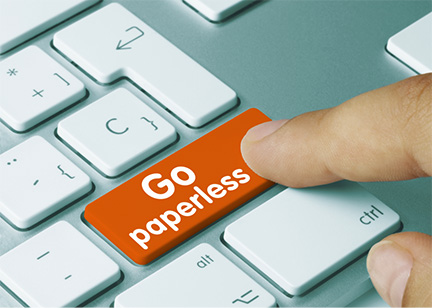According to John Capurso, Vice President of Visioneer, Inc., “Paper is a temporary medium for information, efficient only in small quantities. In large amounts, it is expensive, inefficient in almost every way, and fraught with risk.”1 Paperless recordkeeping is no longer just a goal for many sterile processing departments; it’s a real necessity, for several reasons. Here are some quick stats that show just how expensive paper is.
- It costs on average $5 to file a paper document.
- It costs on average $20 to find a paper document.
- In the end, 7.5% of all paper documents get lost altogether.2
So based on this information, let’s review some benefits of letting go of hard copy documentation.
1. Enhanced opportunity for successful surveys
One of the key components of a successful survey in healthcare is the ability to quickly find and produce the document a surveyor is looking for. Inability to locate the required information may well lead to further investigation. A quick document retrieval may help avoid more time under the microscope.
2. Easy access to information
With the continuation of advanced technologies, there remain very few limitations for getting or retrieving electronic documents. From ultra-thin laptops to tablets and iPads, to smartphones and wearable devices, everyone has quick and accurate access to create, save, store, and share information. Electronic documentation diminishes costly and time-consuming paper searches to a “point and click” repeatable electronic method.
3. Automatic backup
When you misfile or accidentally throw out an important paper, it’s usually gone forever. However, maintaining electronic files allows for multiple backup points.”3 Whether on a flash drive, external hard drive or in the cloud, our documents are saved for future reference. There is typically always a way to get back to the original, clean document without foraging through trash cans.
4. Avoidance of some risks related to document loss
Paper documents are subject to at least two major risks; loss due to physical theft, and loss due to destruction related to a disaster such as fire, or water damage. Capturing information in an electronic format with automated backup helps ensure document security.
5. Better for the environment Cost Savings
While the amount of paper recovered for recycling is increasing, office copy paper alone still accounts for over 20 percent of total paper usage in the United States.
6. Cost Savings
When a facility makes a determination to go paperless, the financial benefits include more than just the cost of the paper. Going paperless helps to reduce the number of costly ink cartridges toner cartridges used in copiers and printers and increase staff productivity due to the fact less time is consumed for record keeping. It’s easy to recognize at the onset that paperless record keeping may not be 100% feasible department-wide. But identifying where it is practical, based on available software and technology, just makes sense. If you are struggling to file, retrieve, or access information in paper files, it’s probably time to move to step up to an electronic document management strategy.


